Museum News for November
We remain temporarily closed to the public due to the Covid-19 pandemic. We continue to work behind the scenes and from home, keeping in touch with you all online through our social media, website and blogging.
 |
|
The Long Road to Re-Opening
We were hoping to announce our re-opening date when the government announced a new ‘lockdown’, postponing our plans again! Closure of museums is compulsory from 5 November until lockdown is lifted, hopefully in December. Progress is being made with the new cashless payments system, although we have experienced set-backs with equipment which had to be replaced. We are working hard to get the new system in fully operational order. In the meantime we concentrate on the positive work of preparing for visitors, adapting services for the ‘new normal’ where possible, and all the routine work of running the Museum and other project we are engaged in. We all look forward to offering visitors the opportunity to engage with our shared cultural and environmental heritage again in a meaningful and enjoyable way.
|
 |
|
QR Code Object Labels
In order to comply with Covid guidelines we have removed all the hand-lists from all the display galleries.
These have been replaced with QR codes produced by Jenny Oxley (Collections Officer, Human History). The codes can be scanned by visitors during their visit when the museum re-opens, so that they can view their own personal copy of the object labels for each display, rather than multiple people touching physical copies of the labels.
|
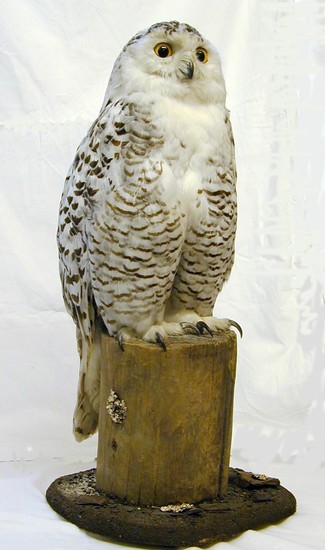 |
|
Learning & Outreach
Saffron Walden Museum is committed to continuing to share stories from its collections through its learning and outreach services.
With the new national lockdown unfortunately we can’t welcome schools or groups to the Museum or offer Outreach sessions.
However our loan boxes are still available for hire, £18 for 6 weeks, and will be quarantined in between hires to ensure they are Covid 19 secure.
We are also developing virtual learning sessions for the lockdown period and offering a bespoke "click and collect" learning packs to schools and groups.
To find out about any of these services or for a list of loan boxes contact our Learning & Outreach Officer Charlotte Pratt via email at cpratt@uttlesford.gov.uk
|
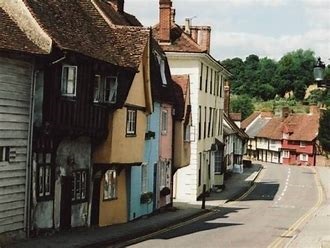 |
|
CV Walden
We are continuing to collect people's experiences of the current Covid-19 outbreak and how it has affected day-to-day life in the district for future generations to understand.
If you are interested in compiling a diary now that we could archive at a later date that would be really beneficial.
We're also interested in audio and video clips, as well as artistic responses to the current situation, such as artwork, poetry and music, etc. If you are part of a community group or organisation - consider asking your members and contacts to take part in this project.
These may be compiled to form an online or physical exhibition in due course.
Contact Jenny Oxley, Collections Officer (Human History) about this project at museum@uttlesford.gov.uk and title your email "CV Walden"
|
 |
|
Object of the Month
The Museum’s ‘Object of the Month’ provides an opportunity to explore interesting and unusual objects from our stores.
November's Object of the Month has been chosen by Carolyn Wingfield, Curator. It's a Late Iron Age butt beaker which takes us back 2,000 years to a small Iron Age community at Birchanger around the time of the Roman conquest of AD 43. This fine pottery beaker, 26 cms tall, was excavated with a cremation burial in 1992 by Essex County Council archaeologists working on the Woodside Industrial Park development, east of Bishop’s Stortford.
Buried with their
Best Beer Mug
Beakers like this were the fashionable drinking vessels of the day for wine or beer. Its capacity is roughly 4 litres or 7 pints. Such vessels may have been passed round at a feast or ceremony, so it does not necessarily represent one person’s intake of drink!
The beaker was made in north Gaul (France) and is an example of the contact and trade in fine wares between south-east Britain and Gaul, before and after the Roman conquest. It was one of eight pots found in the grave; one other beaker was also an import from Gaul and the rest – two cups, two platters, a flagon and a jar – were all from the Essex-Hertfordshire region. There were also four plain bronze brooches for fastening clothes, a leg of pork and a pig’s head, cut in two lengthways. The number of pots and other items indicates this was the burial of a person of high status, presumably a leader of their local community. It is likely that at least some of the other pots held food and drink to complete the feast for the afterlife. Pig’s heads have also been found with late Iron Age burials at Stansted Airport. They were animals of mythical and cultural significance for Iron Age people, so perhaps the pig remains were more than just food offerings. We can imagine the grave-side ceremonies which may have taken place, including feasting and drinking.
To find out more you can check out the Object of the Month post on our website (latest news section) or see it on our blog - links at the end of this newsletter
|
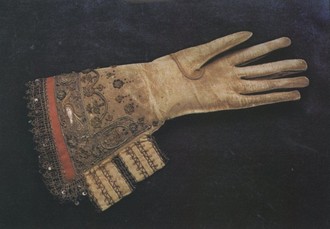 |
|
Royal Connections
This 16th century glove is thought to have been worn by Mary Queen of Scots. It is a gauntlet style glove, which would have been worn on the left hand. It is made from kid leather, which has been decorated with coloured silk and elaborately embroidered with silver wire with gold lace additions. The design, which is repeated on both sides of the gauntlet, includes roses, foliage and trees as well as a bird with a long tail which is pictured in flight. The glove is lined with bright crimson satin, a narrow band of which is turned outwards, and forms a binding on to which is sewn gold lace and there are small silver spangle pendants fastened on to it. The opening at the side of the gauntlet is connected by two broad bands of crimson silk, now much faded, each decorated at the edges with silver lace.
This glove is thought to have been given by Mary on the day of her execution (8th February 1587) to Marmaduke Dayrell who was Master of the Household at Fotheringay Castle as a token for his “faithful devotion to her Highness’ service.” The glove remained for a long time in the possession of the Dayrell family. It was initially loaned to the Museum in 1837 by Frances Dayrell of Shudy Camps Park, Cambridgeshire which is close to Haverhill, before it was later donated to the museum.
|
 |
|
Dubnovellaunos Ruled OK!
This striking gold coin, little bigger than a 5p piece (remember cash?) is 2,000 years old and is a very welcome recent donation to the collections. It was found in the Stansted area and was kindly donated by the finder and landowners (finds of single gold or silver coins are excluded from the Treasure Act).
Long before Britain was absorbed into the Roman Empire in AD 43, the late Iron Age tribes and rulers of southern Britain were issuing their own sophisticated coinage in gold, silver and alloys of copper and tin (bronze and potin). This coin is a small gold denomination known as a quarter stater, and can be attributed to a powerful British leader called Dubnovellaunos. His name means ‘world ruler’ and he may have been king of Kent (Cantiaci tribe) before extending his authority north of the Thames over the Trinovantes tribe (who occupied most of modern Essex and southern Suffolk. If so, Dubnovellaunos was probably displaced as ruler of Essex by Cunobelin in around AD 10.
The obverse has a decorative band or wreath across the centre with two crescents back-to-back, and a round pellet on either side. The reverse, which has been struck off-centre, depicts a horse (a very common motif on late Iron Age coinage) with part of a leafy branch below its hooves and other symbols round it. We do not know exactly what significance al these motifs had to the Iron Age Britons but they struck a huge number of coins in a great variety of designs. The study of these coins and their distribution is an important source of information for a period when we have no written history from Britain and only a small number of references from Roman sources. British rulers did however use the Latin alphabet to add their name to some of their coins, and comparison with named coins means that we can ascribe this little quarter stater to the coinage of Dubnovellaunos.
|
 |
|
Special Roadside Verges
Sarah co-ordinates the special roadside verges scheme for Uttlesford, which gives certain stretches of grass verge extra protections to preserve the fragile plant life found there. These areas are mown periodically to encourage the rare wildflowers to set seed in autumn and grow in spring and summer with reduced competition from grasses, nettles and brambles. James has been helping monitor the autumn cutting regime to ensure the historic flora has the best chance next year.
Planting has begun for a new set of recycled pots to provide flowers and leafy interest at the main entrance throughout the year. One pot is already showing signs of life, with a few cyclamen leaves poking above the surface, and a very brave rogue nasturtium standing tall. Another pot contains daffodils, iris ‘silvery beauty’ and winter aconite ‘orange glow’ ready to start their show early next year, and there’s more to come!
|
 |
|
Pest Monitoring
We are checking traps that catch creatures like moth and carpet beetle larvae that might eat the museum collections. This happens every three months in the Museum and Museum Store buildings. Our Scottish wildcat looks surprised that we have shattered the peace and quiet of the Victorian Museum Workroom display. This predator is the size of a large tabby cat but it has a thick tail, with a blunt black tip and thick black stripes. Wildcats were once found across Britain but now there could be less than 50 wildcats surviving in the Scottish highlands. This is due to historic persecution, habitat loss, disease and interbreeding with feral and domestic cats. Experts are hard working to save this species.
|
 |
|
New Acquisitions
This month we have had some new acquisitions to our World Cultures collections.
Buxton Museum & Art Gallery have been overseeing the disposal of world cultures collections material from the former Derbyshire School Library Service, which is being funded and supported by the Esmee Fairburn charitable trust and the Museums Association.
We applied to acquire a selection of specific items from their collections to develop our own further, and have been lucky enough to receive a wooden ceremonial palm wine cup from the Kuba Bashona, Democratic Republic of the Congo; a wooden 4-legged stool with geometric decoration from East Africa and two African cloth scarfs which have been decorated using a wax resist technique in geometric patterns with beaded tassels.
|
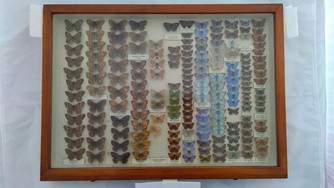 |
|
Lepidoptera Cabinet Update
You may remember from the October edition of our E-News we mentioned about the possibility of us acquiring a cabinet of butterflies and moths from a private collector.
We've now reached an agreement and acquired the cabinet for our collections. James Lumbard, one of our Natural Sciences Officers travelled to Dorset recently to collect the cabinet. This is a great acquisition as it completes a pair with a butterfly cabinet we received back in 2002.
|
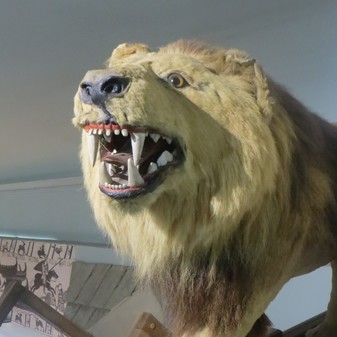 |
|
Virtual Highlights Tour
If you're missing the Museum as much as we are, then you might enjoy watching this quick Youtube virtual highlights tour which was created for us by Saffron Drones.
What's your favourite bit of the Museum?
https://www.youtube.com/watch?v=DgJyRL9oUr0
|
 |
|
#MuseumGames
We're still sharing our online jigsaws based on the museum's collections. How quickly can you solve them? There are alternative designs and versions to suit different levels. Let us know if you have any jigsaw requests and we'll create some more!
https://www.jigsawplanet.com/SWMuseum/
We've also created an online mystery object quiz game which you can find on the museum's Facebook timeline - test your expert knowledge identifying 10 mystery social history objects from our collections, with multiple choice answers to pick from.
|
 |
|
Blogging
Check out our blog for our current behind the scenes activities, new online tutorials, project updates, stories about our collections and insights into our diverse collections.
https://exploresaffronwaldenmuseum.blogspot.com/
How can we develop it further? What stories would you like us to share with you about our collections?
What resources could the museum provide that you might find helpful? - local history, geography, science, maths, art....
|
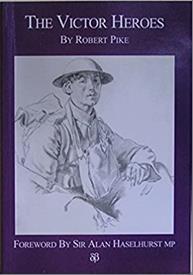 |
|
Museum Shop Spotlight
With Remembrance Day in November....we have on sale the Victor Heroes paperback books, on sale at £12.99.
The book is a record of each of the 159 men named on the Saffron Walden War Memorial and includes detailed biographies.
Jigsaws....
Linked to the museum's acquisition of a new cabinet of butterflies and moths....this month we are also highlighting our bespoke jigsaws....
Unique - Saffron Walden Museum commissioned jigsaw puzzles, inspired by our British Butterfly collection. These are very different to standard jigsaw puzzles:
|
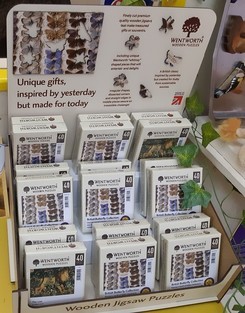 |
|
Whimsy pieces - Victorian puzzle ‘whimsies’ – this jigsaw has bespoke pieces which reflect the nature of the puzzle itself.
Irregular Pieces - The mini jigsaw puzzles (40 pieces) may be small but that doesn't mean they're easy. Perfect for adults and children to complete together or alone they’re still challenging.
British Made Wooden Classic - Not only are they made from sustainable wood, which gives a fabulous tactile feeling, but they are cut using lasers. Laser cutting the pieces ensures that each piece fits together perfectly On sale for just £7.50 each.
|
The museum is closed for the time being, but remains active online...
Website: www.saffronwaldenmuseum.org
Blog: https://exploresaffronwaldenmuseum.blogspot.com/
Email: museum@uttlesford.gov.uk
Phone: 01799 510333
|